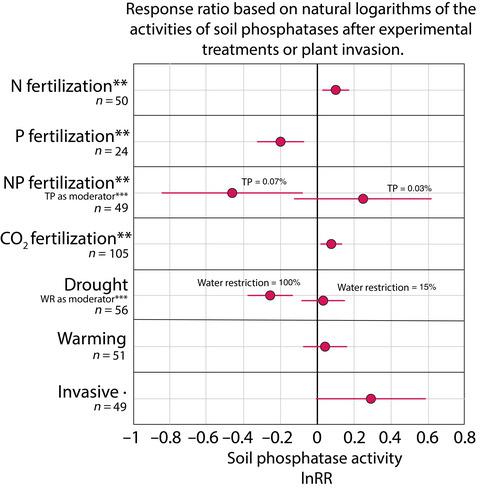当前位置:
X-MOL 学术
›
Glob. Change Biol.
›
论文详情
Our official English website, www.x-mol.net, welcomes your feedback! (Note: you will need to create a separate account there.)
The effect of global change on soil phosphatase activity
Global Change Biology ( IF 11.6 ) Pub Date : 2021-08-12 , DOI: 10.1111/gcb.15832 Olga Margalef 1, 2, 3 , Jordi Sardans 2, 3 , Joan Maspons 2, 3 , Roberto Molowny-Horas 3 , Marcos Fernández-Martínez 4 , Ivan A Janssens 4 , Andreas Richter 5 , Philippe Ciais 6 , Michael Obersteiner 7 , Josep Peñuelas 2, 3
Global Change Biology ( IF 11.6 ) Pub Date : 2021-08-12 , DOI: 10.1111/gcb.15832 Olga Margalef 1, 2, 3 , Jordi Sardans 2, 3 , Joan Maspons 2, 3 , Roberto Molowny-Horas 3 , Marcos Fernández-Martínez 4 , Ivan A Janssens 4 , Andreas Richter 5 , Philippe Ciais 6 , Michael Obersteiner 7 , Josep Peñuelas 2, 3
Affiliation

|
Soil phosphatase enzymes are produced by plant roots and microorganisms and play a key role in the cycling of phosphorus (P), an often-limiting element in terrestrial ecosystems. The production of these enzymes in soil is the most important biological strategy for acquiring phosphate ions from organic molecules. Previous works showed how soil potential phosphatase activity is mainly driven by climatic conditions and soil nitrogen (N) and carbon. Nonetheless, future trends of the activity of these enzymes under global change remain little known. We investigated the influence of some of the main drivers of change on soil phosphatase activity using a meta-analysis of results from 97 published studies. Our database included a compilation of N and P fertilization experiments, manipulation experiments with increased atmospheric CO2 concentration, warming, and drought, and studies comparing invaded and non-invaded ecosystems. Our results indicate that N fertilization leads to higher phosphatase activity, whereas P fertilization has the opposite effect. The rise of atmospheric CO2 levels or the arrival of invasive species also exhibits positive response ratios on the activity of soil phosphatases. However, the occurrence of recurrent drought episodes decreases the activity of soil phosphatases. Our analysis did not reveal statistically significant effects of warming on soil phosphatase activity. In general, soil enzymatic changes in the reviewed experiments depended on the initial nutrient and water status of the ecosystems. The observed patterns evidence that future soil phosphatase activity will not only depend on present-day soil conditions but also on potential compensations or amplifications among the different drivers of global change. The responses of soil phosphatases to the global change drivers reported in this study and the consideration of cost–benefit approaches based on the connection of the P and N cycle will be useful for a better estimation of phosphatase production in carbon (C)–N–P models.
中文翻译:

全球变化对土壤磷酸酶活性的影响
土壤磷酸酶由植物根部和微生物产生,在磷 (P) 循环中起关键作用,磷 (P) 是陆地生态系统中通常的限制元素。在土壤中产生这些酶是从有机分子中获取磷酸根离子的最重要的生物学策略。以前的工作表明土壤潜在磷酸酶活性主要受气候条件和土壤氮 (N) 和碳的驱动。尽管如此,在全球变化下这些酶活性的未来趋势仍然鲜为人知。我们使用对 97 项已发表研究结果的荟萃分析,调查了一些主要变化驱动因素对土壤磷酸酶活性的影响。我们的数据库包括 N 和 P 施肥实验的汇编,增加大气 CO 的操作实验2集中、变暖和干旱,以及比较入侵和非入侵生态系统的研究。我们的结果表明施氮导致更高的磷酸酶活性,而施磷具有相反的效果。大气CO 2的上升水平或入侵物种的到来也对土壤磷酸酶的活性表现出积极的反应比率。然而,反复发生的干旱事件会降低土壤磷酸酶的活性。我们的分析没有揭示变暖对土壤磷酸酶活性的统计学显着影响。一般来说,在审查的实验中土壤酶的变化取决于生态系统的初始养分和水分状况。观察到的模式表明,未来的土壤磷酸酶活性不仅取决于当前的土壤条件,还取决于全球变化不同驱动因素之间的潜在补偿或放大。
更新日期:2021-10-15
中文翻译:

全球变化对土壤磷酸酶活性的影响
土壤磷酸酶由植物根部和微生物产生,在磷 (P) 循环中起关键作用,磷 (P) 是陆地生态系统中通常的限制元素。在土壤中产生这些酶是从有机分子中获取磷酸根离子的最重要的生物学策略。以前的工作表明土壤潜在磷酸酶活性主要受气候条件和土壤氮 (N) 和碳的驱动。尽管如此,在全球变化下这些酶活性的未来趋势仍然鲜为人知。我们使用对 97 项已发表研究结果的荟萃分析,调查了一些主要变化驱动因素对土壤磷酸酶活性的影响。我们的数据库包括 N 和 P 施肥实验的汇编,增加大气 CO 的操作实验2集中、变暖和干旱,以及比较入侵和非入侵生态系统的研究。我们的结果表明施氮导致更高的磷酸酶活性,而施磷具有相反的效果。大气CO 2的上升水平或入侵物种的到来也对土壤磷酸酶的活性表现出积极的反应比率。然而,反复发生的干旱事件会降低土壤磷酸酶的活性。我们的分析没有揭示变暖对土壤磷酸酶活性的统计学显着影响。一般来说,在审查的实验中土壤酶的变化取决于生态系统的初始养分和水分状况。观察到的模式表明,未来的土壤磷酸酶活性不仅取决于当前的土壤条件,还取决于全球变化不同驱动因素之间的潜在补偿或放大。



























 京公网安备 11010802027423号
京公网安备 11010802027423号